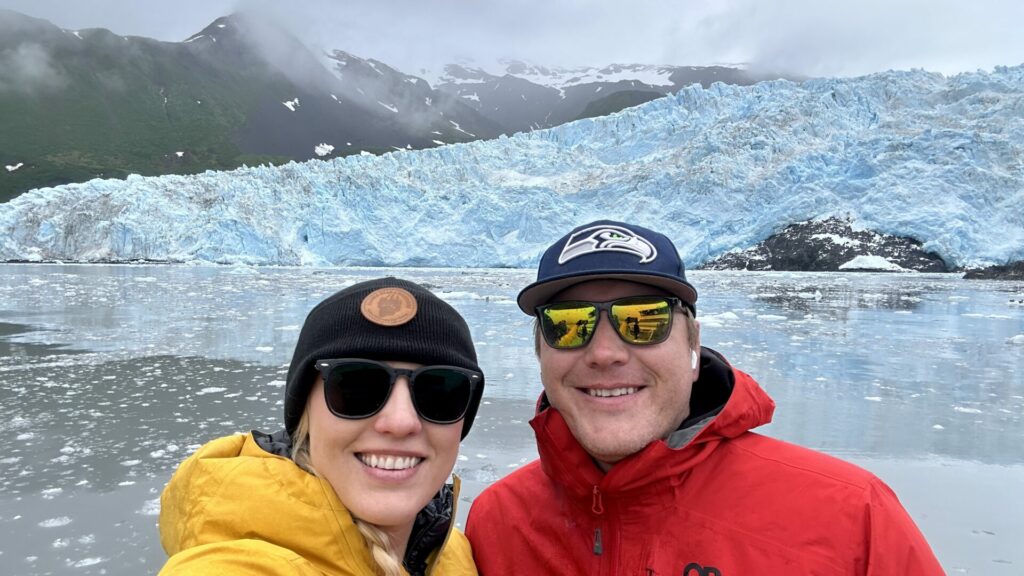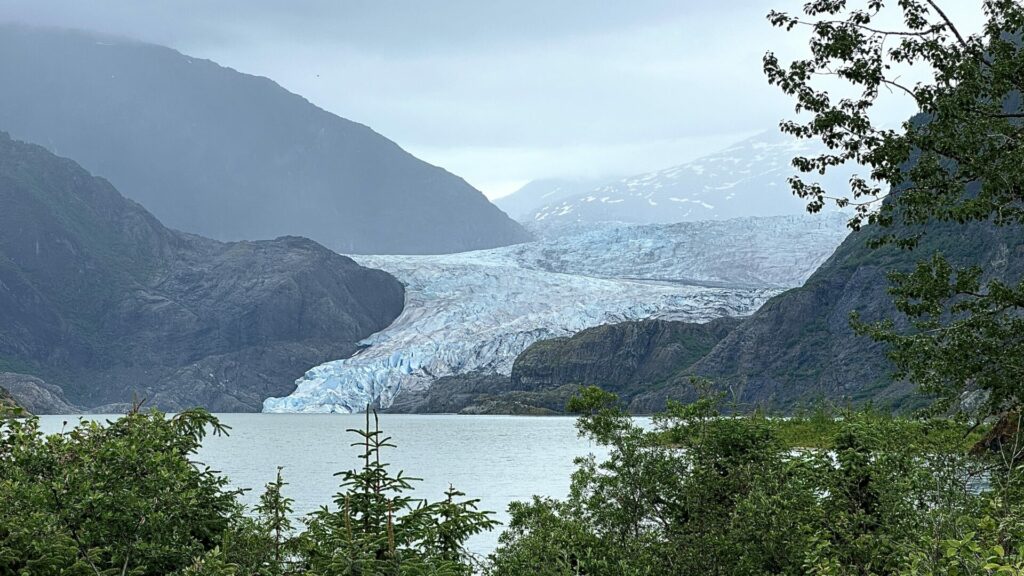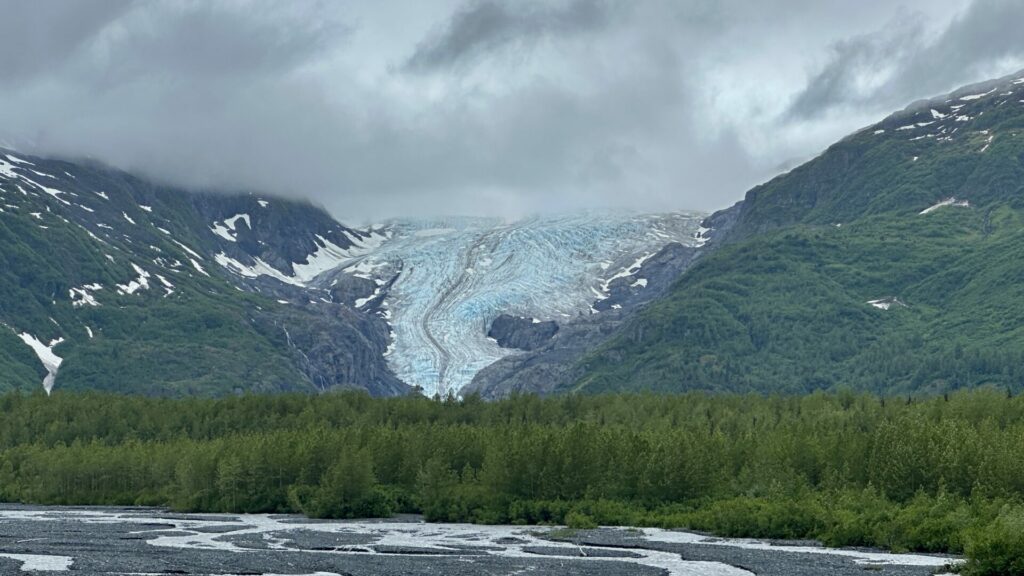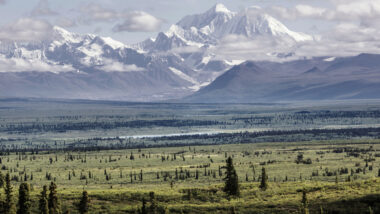Table of Contents Show
When travelers plan a road trip to Alaska, excursions usually include wildlife and viewing glaciers. Elk, bears, moose, caribou, and Dall sheep are abundant. Sheets of ice cover 5% of the state, which may not seem like much, but this includes 29,000 square miles.
There are more glaciers in Alaska than in any other state. So, let’s look closer at these massive ice sheets to discover which are the biggest and most accessible!
What Is a Glacier?
A glacier is made up of dense ice and forms only on land, although some glaciers empty into bodies of water. Glaciers are constantly moving; they can grow or shrink.
They’re found in polar regions and mountain ranges. In fact, there are glaciers on every continent except the Australian mainland. Pakistan has the most glaciers of any country outside the Poles.

The Different Types of Glaciers
However, even though that’s a broad definition of glaciers, every glacier isn’t the same. Alpine glaciers begin in the mountains. Many terminate in the mountain valleys, while others remain entirely in the mountains.
Glacier National Park, Grand Teton National Park, Mount Rainier National Park, North Cascades National Park, and Yosemite National Park have alpine glaciers.
Valley glaciers are confined to valleys, but they’re considered piedmont glaciers if they grow or move into the flatlands. Kenai Fjords National Park, Wrangell-St. Elias National Park and Preserve, and Glacier Bay National Park and Preserve have valley and piedmont glaciers.
Some of the best glaciers for viewing are tidewater glaciers. They form on land and terminate in bodies of water. Often, boat or kayak tours take visitors to these massive sheets of ice. The calving of these glaciers produces floating icebergs.
There are numerous national parks in the United States where visitors can view tidewater glaciers, from seven of the Alaskan parks to the North Cascades and Olympic National Park in Washington.
Rock glaciers, ice sheets, ice fields, and ice caps are also part of the glacier family. The only modern-day ice sheets are in Greenland and Antarctica.
Pro Tip: Our favorite glacier viewing experience was via Jet Ski in Whitter, AK. Check out Our Honest Review of Glacier Jet Ski Adventures to read all about this awesome excursion!

Where Is the Biggest Glacier In the World?
The Lambert Glacier in Antarctica is the biggest in the world. It’s approximately 50 miles wide, over 250 miles long, and about 2,500 meters deep.
It’s also one of the fastest-moving glaciers as it flows to the Amery Ice Shelf.
There Are Thousands of Glaciers In Alaska
Although there are thousands of glaciers in Alaska, only about 660 have been named. However, the number continues to change. Large ones split to form multiple glaciers.
Other glaciers are shrinking due to global warming. Scientists are more interested in the total glacial land coverage than the actual number of glaciers.

The Biggest Glacier in Alaska
The Bering Glacier, located south of Wrangell-St. Elias National Park is the largest glacier in Alaska. It’s also the largest glacier in North America at 126 miles long.
Although it covers 1,900 square miles, it’s retreating and shrinking due to rising temperatures.
The Matanuska Glacier is the biggest, most accessible glacier by road. Visitors can even walk on this glacier.
This is unique because many of the glaciers in Alaska can only be viewed from a boat’s deck or an airplane’s windows. The Matanuska Glacier is a valley glacier that measures 27 miles long and 4 miles wide.
The Best Glaciers in Alaska
A trip to Alaska isn’t complete without visiting some of its massive glaciers. Whether you want to see roadside glaciers on your own or prefer to book a boat or flightseeing tour, dozens of glaciers are accessible to visitors. Here are our top suggestions!
Roadside Glaciers
Roadside glaciers are glaciers you can reach without a guided tour. You may have to walk a little to get to the glacier, but you can access them with your vehicle. Make sure to dress in layers. Cooler temperatures and wind will greet you near these glaciers in Alaska.
Mendenhall Glacier
In Tongass National Forest near Juneau, you’ll find a 12-mile-long glacier. Trails leading to the Mendenhall Glacier vary in length and difficulty. The West Glacier Trail will take you right up to the face of the glacier. But it’s almost 7 miles long.
A shorter trail will lead visitors to a viewing platform, and a more challenging, rugged Nugget Falls trail will take hikers to a giant 5-story-high waterfall. The East Glacier Trail measures 3.5 miles long.

Exit Glacier
Although not one of the larger glaciers in Alaska, Exit Glacier is very accessible. Travel the Seward Highway to mile 3.7. The turn-off is nine miles long, and half of it is gravel. Located in Kenai Fjords National Park, Exit Glacier is one of the major attractions.
Ranger-led walks are available during the summer season. However, the road is closed to cars in winter once the snow arrives. Snowmobilers, mushers, and cross-country skiers can still access the glacier. Sadly, due to rising temperatures, Exit Glacier is retreating every year.

Matanuska Glacier
About 100 miles north of Anchorage sits Matanuska Glacier. As you travel the Glenn Highway, take advantage of the pull-outs to view this massive ice sheet.
You cannot get close to the glacier without a tour, but you can see the 27-mile-long, 4-mile-wide valley glacier from the highway. Because of its size and the amount of water it releases, Matanuska Glacier forms the Matanuska River at its terminus.
Keep in Mind: While in Alaska, you don’t want to skip out on the Turnagain Arm Drive! The scenery and wildlife sightings make for an unforgettable drive.

Boatside Glaciers
Other glaciers are only accessible by boat or kayak. Outfitters in Alaska offer all kinds of tours to explore these glaciers. You can take an entire day or just a few hours to explore the glaciers.
Hubbard Glacier
Depending on the weather, boat cruises may have to keep their distance from Hubbard Glacier due to fog.
But no matter how close you can get, the 6-mile wide glacier with a 400-foot tall face will take your breath away. This tidewater glacier is off the coast of Yakutat and is the largest glacier cruise ships visit.
Glacier Bay National Park
There are over 1,000 glaciers in Glacier Bay National Park and Preserve. The tidewater glaciers include Margerie Glacier, Grand Pacific Glacier, McBride Glacier, Lamplugh Glacier, Johns Hopkins Glacier, Gilman Glacier, and LaPerouse Glacier.
Margerie Glacier measures about 21 miles long and 250 feet high. Unlike other glaciers in Alaska that have been retreating, Margerie Glacier has grown over the last few decades. Grand Pacific Glacier sits in both the United States and Canada. It stretches 16 miles long.

Prince William Sound
The Prince William Sound has more tidewater glaciers than anywhere in the world. The area is just 70 miles wide, but you’ll find approximately 150 glaciers, 17 of them tidewater glaciers.
Although larger cruise ships don’t travel here as often, this is a popular destination for day cruises. Numerous outfitters in Whittier and Valdez offer boat tours or kayak tours to Prince William Sound to witness the calving and beauty of these behemoths.
Columbia Glacier
Columbia Glacier is located in Prince William Sound, but it’s worth mentioning. It’s one of the fastest-moving glaciers in the world. Columbia Glacier is approximately 550 meters thick and covers 400 square miles.
But sadly, like many glaciers in Alaska, it’s retreating and shrinking in size every year. Day cruises from Valdez most often visit Columbia Glacier.

Keep in Mind: We got up close and personal with the Columbia Icefield Glacier while in Canada, which was a highlight of our trip. Check out the Columbia Icefield Glacier Adventure Tour!
Flightseeing Glaciers
Another way to see the glaciers in Alaska is via flightseeing tours. Helicopters and airplanes take visitors over these massive ice sheets. Not only do you see the grandeur of these glaciers, but you also witness the majesty and beauty of the Alaskan landscape.

Ruth Glacier
Ruth Glacier is an alpine glacier located in Denali National Park and Preserve. The glacier’s Great Gorge would be deeper than the Grand Canyon if the ice completely melted.
As you fly through the gorge, you’ll see 5,000-foot granite walls and glacial ice almost 4,000 feet thick. Some tours also offer hiking trips along with flightseeing excursions.
Knik Glacier
If you’d like to spend a day exploring an Alaskan glacier, a flightseeing tour to Knik Glacier followed by an ATV ride, hike, or paddling trip may be the ideal adventure.
Located on the northern edge of the Chugach Mountains, Knik Glacier is 25 miles long and terminates in a lake that feeds the Knik River. It’s about 50 miles from Anchorage, making a plane ride a short trip to view this stunning landform.
Glaciers in Other States
Alaska isn’t the only state with glaciers, although it has the largest number and size.
According to the Geographic Names Information System, about 186 named glaciers lie in Washington, 35 named glaciers lie in Oregon, 20 named glaciers in California, 16 named glaciers in Colorado, 60 named glaciers in Montana, and 37 named glaciers are in Wyoming.
When Mount St. Helens erupted in 1980, it eliminated nine of its 11 glaciers. Today, the two remaining glaciers aren’t recognized.
However, the caldera now has a newly formed glacier. Mount Ranier has 25 named glaciers, including the largest in the contiguous United States: Emmons Glacier. It covers 4.3 square miles.

Be Inspired: Alaska’s Magnificent Glaciers Will Take Your Breath Away
The glaciers in Alaska are unlike anything else in North America. Whether you want to see a sheet of ice sprawling across the landscape for miles or witness the calving of tidewater glaciers, these magnificent landforms are awe-inspiring.
The next time you visit Alaska, plan a trip to one of the famous roadside glaciers or book a boat or flightseeing tour to view more remote locations. You certainly won’t be disappointed!
Have you ever seen a glacier up close? Would you like to hike on one of these massive ice sheets?






